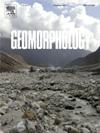Impulse wave run-up mechanism for typical landslides in complex terrains
IF 3.1
2区 地球科学
Q2 GEOGRAPHY, PHYSICAL
引用次数: 0
Abstract
Impulse wave run-up is an important index to measure the impact of impulse waves and potential damage caused by landslides. Three-dimensional microtopography strongly affects the impulse wave run-up. In complex terrains, the mechanism of the run-up is unclear. Hence, in this study, 53 groups of run-up tests were performed in a test site for 3D landslide-induced impulse waves in the Wangjiashan (WJS) section of Baihetan reservoir in Jinsha River under different volume and sliding speed conditions. The run-up mechanism of the impulse wave in complex terrains characterized by gullies, estuaries, and tributary bends was analyzed. Through particle image velocimetry (PIV) flow field analysis, it was found that the impulse wave run-up speed in the gully increased rapidly, and a high-speed zone was formed in the middle of the narrow zone and the rotation zone of the gully mouth. In the estuary terrain, the estuary water diversion and terrain groove were the hardest hit areas by the impulse wave run-up. The attenuation rate of the run-up from the tributary bend to the Xiaojiang bank slope area was up to 70 %. The impact center of the bend was roughly linear with the run-up on the straight bank slope of the Xiaojiang river, and the ratio was 2.51. Based on the different run-up characteristics, such as the run-up incident angle under unconfined and confined propagations of the impulse wave in the reservoir area, two run-up formulae were derived by multiple regression, and their accuracy rates were 75.2 % and 61.5 %. Finally, the Gongjiafang landslide in the Three Gorges Reservoir area was taken as an example to verify the proposed formulae; the average error was 9.7 %. The study results provide an in-depth understanding of the mechanism of landslide-induced impulse wave run-up under complex terrain conditions and theoretical support for run-up calculations.
求助全文
约1分钟内获得全文
求助全文
来源期刊

Geomorphology
地学-地球科学综合
CiteScore
8.00
自引率
10.30%
发文量
309
审稿时长
3.4 months
期刊介绍:
Our journal''s scope includes geomorphic themes of: tectonics and regional structure; glacial processes and landforms; fluvial sequences, Quaternary environmental change and dating; fluvial processes and landforms; mass movement, slopes and periglacial processes; hillslopes and soil erosion; weathering, karst and soils; aeolian processes and landforms, coastal dunes and arid environments; coastal and marine processes, estuaries and lakes; modelling, theoretical and quantitative geomorphology; DEM, GIS and remote sensing methods and applications; hazards, applied and planetary geomorphology; and volcanics.
 求助内容:
求助内容: 应助结果提醒方式:
应助结果提醒方式:


